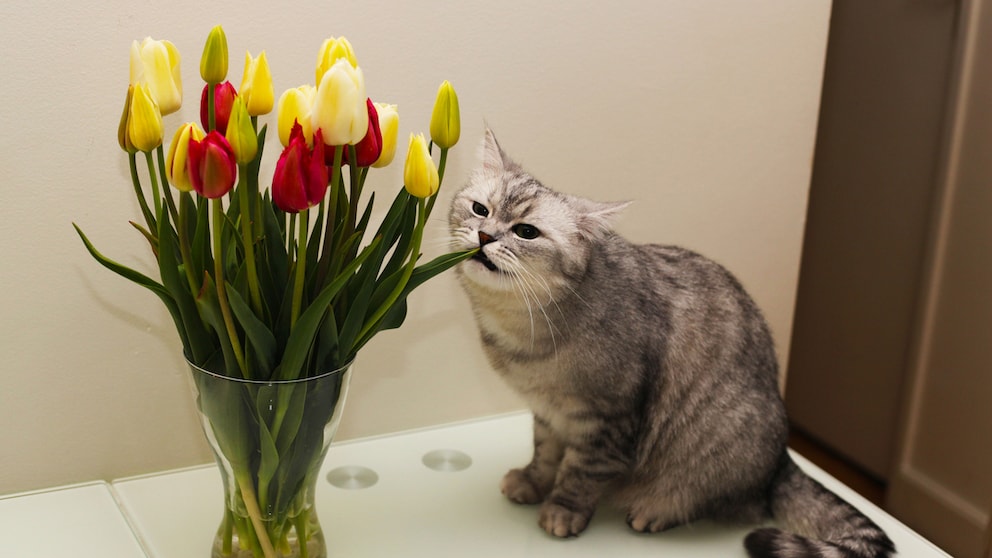March 20, 2025, 9:23 am | Read time: 4 minutes
Spring flowers are particularly tempting for cats — especially colorful bouquets of tulips. In a vase in the home, they also attract cats, who love to munch on the leaves and flowers. But be careful! Many early bloomers are not only poisonous to us humans. PETBOOK editor and biologist Saskia Schneider explains what to do if your cat has nibbled on tulips.
Cats have a natural inclination to nibble on plants. Bouquets of flowers are especially enticing to them. These bouquets carry a myriad of intriguing scents that often prompt immediate investigation by cats. It’s not uncommon for leaves or flowers to quickly find their way into a cat’s mouth. But be careful! Many elements of early-blooming plants are poisonous to cats, and this includes the widely-gifted tulips.
Why Tulips Are Poisonous to Cats
Tulips contain the plant substance tulipanin. Among other things, it gives the early bloomers their pretty color. However, tulipanin is present not only in the flowers but also in the stems, leaves, and, most notably, the bulbs.
Tulipanin is poisonous and can cause damage both internally and externally. If humans come into direct skin contact with the bulbs, for example, this can lead to a skin rash. Cats and other pets often inadvertently poison themselves by orally ingesting these toxic substances when they consume the leaves or flowers.
Are Tulip Flowers Also Poisonous to Cats?
While tulip petals are edible and even considered a delicacy for humans, They are said to taste slightly sweet. Many people, therefore, believe that it is not so bad if their pets eat the petals of tulips. However, for cats, even the tulip flowers are toxic due to their smaller body mass.
Under no circumstances should cats be allowed to drink water from a vase containing tulips. Tulips also release the poisonous substance into the water. Therefore, if you absolutely want to have a bunch of tulips in your home, you should place them out of reach of curious four-legged friends.
Symptoms of Poisoning if a Cat Has Eaten Tulips
If a cat eats tulips, there is a risk of poisoning. This usually manifests itself through
- increased salivation
- diarrhea
- vomiting
Cats typically vomit soon after consuming plant parts, which can prevent more severe health issues. Nevertheless, you should keep a close eye on your cat and, if in doubt, go to the vet, especially if it has eaten large quantities of tulips.
What to Do if Your Cat Has Eaten Tulips
Should you discover your cat nibbling on tulips, it’s crucial to remove them from the plant’s vicinity at once. If possible, carefully remove the plant remains from the cat’s mouth to prevent further swallowing. Subsequently, it’s vital to provide the cat with fresh water, which may help to dilute the toxins to some extent.
However, if the animal is already showing the first symptoms of poisoning, such as vomiting or diarrhea, it should be closely observed. In severe cases or if the cat has eaten large quantities, a visit to the vet is advisable. If available, remnants of the plant or vomit should be taken along to facilitate the diagnosis.
Can I Plant Tulips in the Garden if I Have a Cat?
Although tulips are poisonous to cats, cats generally prefer grass to nibble on. As there is plenty of grass in the garden, cats rarely go for tulips in the flowerbed or on the lawn.
As a bouquet of flowers in the room, early bloomers are particularly interesting if the cat has no alternatives, such as cat grass. So, if you want to prevent the animals from eating the tulips, it can help to place a pot of cat grass within easy reach.
Indeed, tulips pose a toxic threat not only to humans and cats but to a variety of other household pets as well. Dogs, rabbits and guinea pigs should therefore not come anywhere near the petals, otherwise things could quickly get dicey. Consequently, all pet owners should heed this advice: it’s wisest to place tulips well beyond the reach of your four-legged companions or to forgo them entirely.

Tulips, Daffodils, and Co. Which Early Bloomers Are Poisonous to Cats and Dogs?

Secured Outdoor Access How to cat-proof your balcony and keep it varied

Cucumber, pumpkin, zucchini … Can cats eat vegetables?
Sources
- plantura.garden, “Tulips: poisonous or not?” (accessed on 05.03.2024)
- heilpraxisnet.de, “Tulip – ingredients, effects and cultivation” (accessed on 05.03.2024)
- tierarzt-notdienst-berlin.de, “Tulips in the home” (accessed on 05.03.2024)

